Tundra Swan
- February 27, 2024
- 0 comment
The Tundra Swan, scientifically known as Cygnus columbianus, is a magnificent waterfowl species that inhabits the vast expanses of the Arctic and subarctic regions across North America, Europe, and Asia. Renowned for its elegant appearance and graceful demeanor, the Tundra Swan is characterized by its striking snowy-white plumage, long neck, and distinctive black bill. These majestic birds typically inhabit a variety of wetland habitats, including lakes, ponds, marshes, and coastal estuaries, where they forage on aquatic vegetation such as pondweeds and sedges.
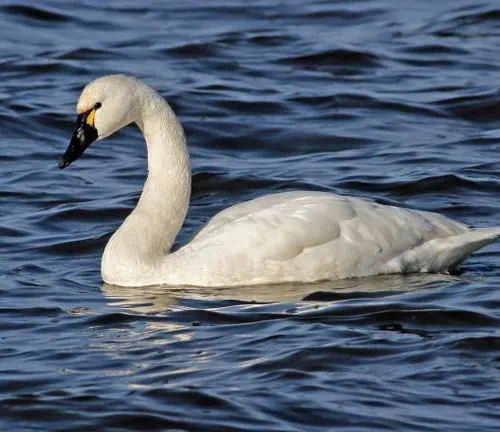
During the breeding season, Tundra Swans form monogamous pairs and establish nesting territories in remote tundra regions, where they construct nests near water bodies. One of the most remarkable aspects of Tundra Swans is their impressive migratory journeys, as they undertake extensive migrations between their breeding and wintering grounds, covering thousands of miles. Despite facing threats such as habitat loss, pollution, and hunting pressure, conservation efforts are underway to protect these iconic birds and their fragile Arctic ecosystems.
Tundra Swans hold cultural significance in indigenous folklore and traditions, symbolizing purity, grace, and resilience. By understanding and appreciating the beauty of Tundra Swans, we can work towards ensuring their survival for generations to come.
| Specifications | Description |
|---|---|
| Scientific Name | Cygnus columbianus |
| Common Name | Tundra Swan |
| Habitat | Arctic and subarctic regions |
| Distribution | North America, Europe, Asia |
| Plumage | Snowy-white |
| Bill | Distinctive black |
| Size | Up to 5 feet in length, wingspan over 6 feet |
| Feeding Habits | Herbivorous, feeding on aquatic vegetation |
| Breeding Behavior | Monogamous pairs, nest in remote tundra regions |
| Migration Patterns | Extensive migrations between breeding and wintering grounds |
| Threats | Habitat loss, pollution, hunting pressure |
| Conservation Status | Not endangered, conservation efforts ongoing |
| Cultural Significance | Symbolizes purity, grace, and resilience |

Tundra Swans, scientifically known as Cygnus columbianus, are majestic avian creatures found predominantly in Arctic and subarctic regions. Renowned for their striking appearance and graceful demeanor, these birds captivate the imagination of birdwatchers and nature enthusiasts worldwide. In this article, we delve into the fascinating world of Tundra Swans, exploring their habitat, behavior, conservation status, symbolism, and more.
What is a Tundra Swan?
Tundra Swans are large waterfowl belonging to the family Anatidae, characterized by their long necks, distinctive black bills, and snowy-white plumage. They inhabit a variety of wetland habitats, including lakes, ponds, marshes, and coastal estuaries.
Habitat and Distribution
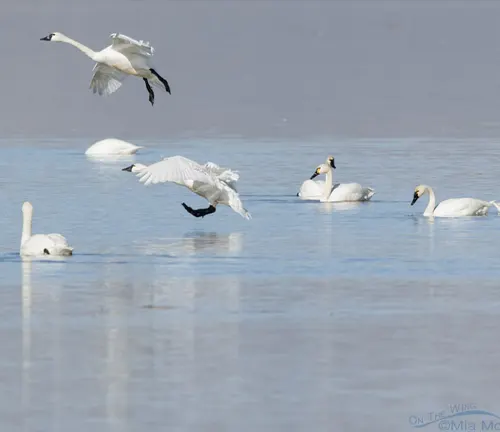
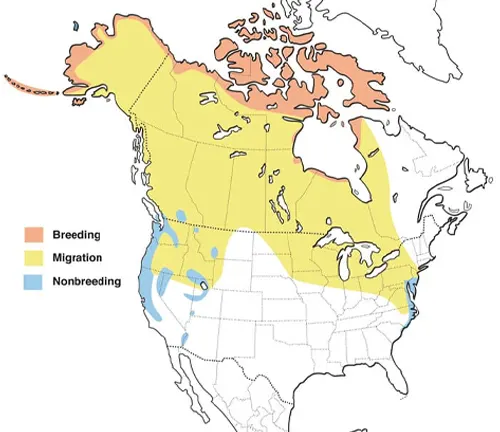
The habitat and distribution of Tundra Swans are closely intertwined with their unique breeding and wintering behaviors. These elegant waterfowl primarily inhabit Arctic and subarctic regions across North America, Europe, and Asia. During the breeding season, Tundra Swans seek out remote tundra habitats rich in ponds, shallow lakes, and wetlands, where they establish nesting territories. These breeding grounds provide essential resources for nesting, feeding, and raising their young.
In North America, Tundra Swans breed in the vast expanses of the Arctic, including regions of Alaska, Canada, and Greenland. In Eurasia, they breed in parts of Russia and Siberia. These breeding habitats offer the necessary seclusion and safety for Tundra Swans to rear their offspring away from predators and disturbances.
As the seasons change and temperatures drop, Tundra Swans embark on remarkable migratory journeys to their wintering grounds. During migration, they traverse thousands of miles, crossing vast landscapes and bodies of water. In North America, Tundra Swans migrate to wintering grounds along the Atlantic and Pacific coasts, as well as inland lakes and marshes. In Eurasia, they migrate to wintering areas in Western Europe and Asia, including the United Kingdom, the Netherlands, and China.
The wintering habitats of Tundra Swans vary, encompassing coastal estuaries, marshes, and wetlands with abundant food resources. These areas provide critical foraging grounds where Tundra Swans can feed on aquatic vegetation and other food sources to sustain themselves during the winter months.
Physical Characteristics
Size and Appearance
Tundra Swans are among the largest waterfowl species, boasting impressive dimensions that contribute to their majestic presence. Adults can reach lengths of up to five feet (1.5 meters) from beak to tail and possess wingspans exceeding six feet (1.8 meters). Their bodies are sleek and streamlined, adorned with a long, graceful neck that they often arch elegantly. Despite their large size, Tundra Swans exhibit a remarkable gracefulness in their movements, whether in flight or on water. These physical characteristics contribute to their striking appearance and make them a captivating sight for observers in their natural habitat.
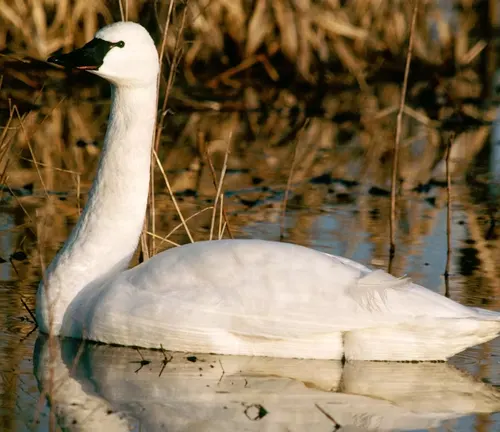

Plumage
One of the most distinctive features of Tundra Swans is their pristine white plumage, which covers most of their bodies. Their feathers are soft and dense, providing insulation against the harsh Arctic temperatures they encounter during the breeding season. The snowy-white coloration of their plumage serves as effective camouflage against the snowy landscapes of their breeding grounds, helping them blend in with their surroundings and evade potential predators. In addition to their white feathers, Tundra Swans also sport contrasting jet-black bills and legs, which stand out prominently against their snowy backdrop. This striking color contrast adds to their visual appeal and makes them easily recognizable among other waterfowl species.
Behavior and Migration
Feeding Habits
Tundra Swans are primarily herbivorous, with their diet consisting mainly of aquatic vegetation. They forage in shallow water or graze on land, using their long necks to reach submerged plants. Their preferred food includes pondweeds, sedges, grasses, and other aquatic plants found in their wetland habitats. Tundra Swans are adept at upending in shallow water to reach underwater vegetation or grazing on vegetation along the water’s edge. Their herbivorous diet provides them with the necessary nutrients to sustain their energy levels during their demanding migratory journeys and breeding seasons.

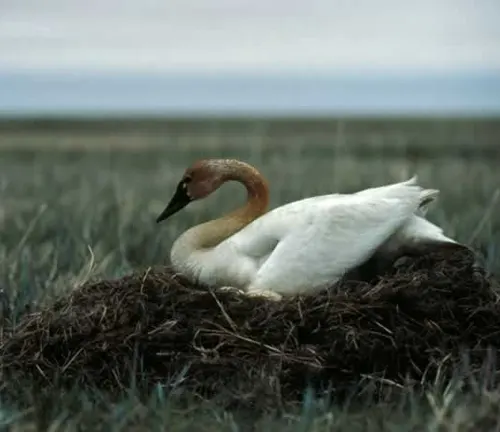
Breeding and Nesting Behavior
During the breeding season, Tundra Swans form monogamous pairs and establish nesting territories in remote tundra regions. The female selects a suitable nesting site near water bodies, where she constructs the nest using plant materials and down feathers. Tundra Swan nests are typically large and bulky, situated on the ground and lined with soft materials for insulation and comfort. Both parents take turns incubating the eggs, which hatch after a period of approximately 30 days. Once the cygnets hatch, they are cared for by both parents, who diligently protect and feed them until they are ready to fledge and join the flock.
Migration Patterns
Tundra Swans are renowned for their impressive migratory journeys, which take them thousands of miles between their breeding and wintering grounds. In autumn, as temperatures drop and food becomes scarce in their northern breeding habitats, Tundra Swans embark on southward migrations to warmer climates. They form large flocks and follow established migratory routes, often flying in V-shaped formations to reduce wind resistance and conserve energy. Along the way, they stop at various staging areas to rest and refuel before continuing their journey. Tundra Swans winter in coastal marshes, estuaries, and inland lakes, where they find ample food resources to sustain them until the return of spring prompts their northward migration once again.
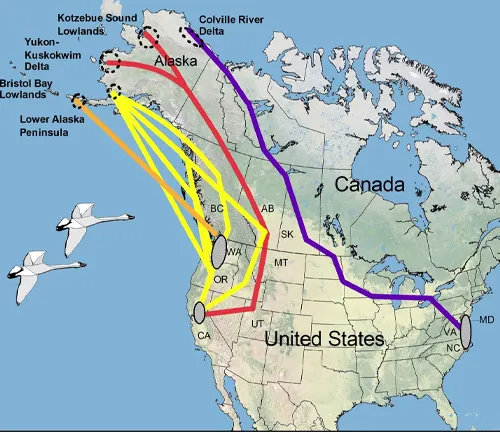
Conservation Status
Threats
Despite their adaptability, Tundra Swans face various threats to their survival, primarily stemming from human activities and environmental changes. Habitat loss and degradation pose significant threats, as wetlands are drained for agricultural expansion, urban development, and infrastructure projects. Pollution from agricultural runoff, industrial activities, and oil spills contaminates their water sources and affects their food supply. Tundra Swans are also vulnerable to hunting pressure, both legal and illegal, particularly during their migratory journeys. Climate change exacerbates these threats, altering the availability of suitable breeding and wintering habitats and disrupting their migratory patterns.
Conservation Efforts
Efforts to conserve Tundra Swans and their habitats are underway, involving a combination of research, habitat protection, and community engagement. Conservation organizations collaborate with government agencies, researchers, and local communities to implement measures aimed at safeguarding Tundra Swan populations and their ecosystems. Wetland conservation initiatives focus on restoring and protecting critical breeding and wintering habitats, including the designation of protected areas and wetland reserves. Habitat management practices, such as controlling invasive species and restoring natural water flow, help enhance habitat quality for Tundra Swans and other wetland-dependent species. Hunting regulations and international agreements regulate the hunting of Tundra Swans, ensuring sustainable harvests and preventing overexploitation. Public awareness campaigns raise awareness about the importance of Tundra Swan conservation and encourage community participation in monitoring and conservation efforts. By addressing these threats and implementing conservation measures, we can ensure the continued survival of Tundra Swans and preserve their role in our natural ecosystems.
Tundra Swan Symbolism
Cultural Significance
Tundra Swans hold profound cultural significance in indigenous folklore and traditions, symbolizing purity, grace, and resilience. Across various cultures, these majestic birds are revered for their elegant appearance and graceful demeanor, often featuring prominently in myths, legends, and artistic representations. In Native American cultures, Tundra Swans are regarded as symbols of wisdom, beauty, and spiritual guidance, with stories depicting their role as messengers between the human and spiritual realms. Their annual migrations are celebrated as symbols of renewal and rebirth, marking the changing seasons and the cyclical nature of life. In European folklore, Tundra Swans are associated with themes of love and fidelity, often depicted as symbols of eternal devotion in romantic tales and poetry. Their ethereal beauty and graceful movements inspire awe and reverence among those who encounter them, underscoring their cultural significance as icons of the natural world.
Conservation Symbolism
As ambassadors of Arctic ecosystems, Tundra Swans symbolize the importance of preserving fragile habitats and biodiversity. Their conservation serves as a rallying point for environmental stewardship and awareness.
Different Species
Tundra Swan
(Cygnus columbianus columbianus)
Also known as the “Whistling Swan,” this subspecies breeds in the North American Arctic and winters along the Atlantic and Pacific coasts of North America. It is characterized by a slightly smaller size compared to the Bewick’s Swan, with a more extensive yellow patch at the base of its bill.

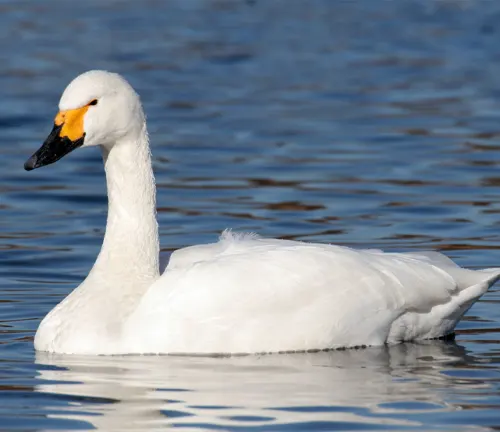
Bewick’s Swan
(Cygnus columbianus bewickii)
Named after the renowned British engraver Thomas Bewick, this subspecies breeds in the Arctic regions of Eurasia and migrates to wintering grounds in Western Europe and Asia. Bewick’s Swans are distinguished by their smaller size, shorter necks, and more extensive yellow patch on their bills, which extends to the nostrils.
Frequently Asked Questions (FAQs)
- Are Tundra Swans endangered?
Tundra Swans are currently not classified as endangered. However, conservation efforts are crucial to safeguard their populations and habitats. - How far do Tundra Swans migrate?
Tundra Swans undertake extensive migrations, traveling thousands of miles between their breeding and wintering grounds. - Can Tundra Swans fly?
Yes, Tundra Swans are proficient fliers, capable of covering long distances during their migratory journeys. - What is the lifespan of a Tundra Swan?
Tundra Swans can live up to 20 years or more in the wild, depending on factors such as predation, habitat quality, and environmental conditions. - How can I help conserve Tundra Swans?
You can support Tundra Swan conservation efforts by advocating for wetland protection, reducing pollution, and participating in citizen science initiatives to monitor bird populations. - Do Tundra Swans migrate in flocks?
Yes, Tundra Swans often migrate in large flocks, which provides safety in numbers during their long journeys. - What do Tundra Swans eat?
Tundra Swans primarily feed on aquatic vegetation such as pondweeds, sedges, and grasses found in their wetland habitats. - How do Tundra Swans communicate?
Tundra Swans communicate through various vocalizations, including honking calls, which they use to maintain contact with flock members and establish territory. - Where can I find Tundra Swans for birdwatching?
Tundra Swans can be observed in their breeding habitats in the Arctic during the summer months and in coastal areas or inland lakes during migration and winter. - Are Tundra Swans protected by law?
Yes, Tundra Swans are protected under various wildlife conservation laws and international agreements, which regulate hunting and habitat protection. - What predators do Tundra Swans face?
Tundra Swans face predation from various animals, including foxes, wolves, bears, and birds of prey, which may prey on eggs, young cygnets, or vulnerable adults during nesting or migration. - How do Tundra Swans find their migration routes?
Tundra Swans have an innate ability to navigate their migration routes using celestial cues, landmarks, and environmental cues such as wind patterns and magnetic fields.



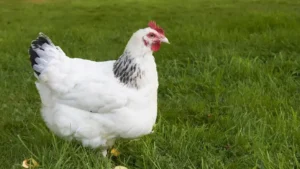
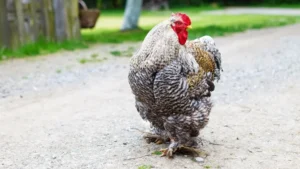
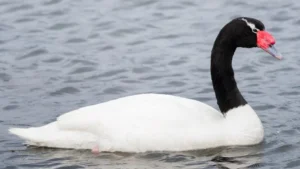
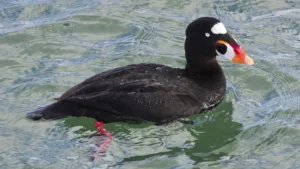
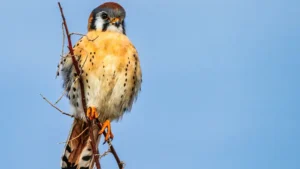
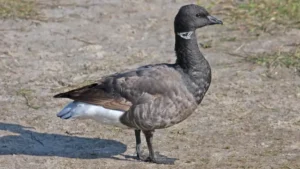

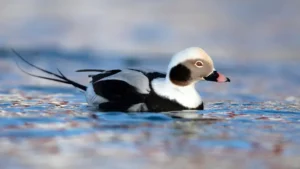

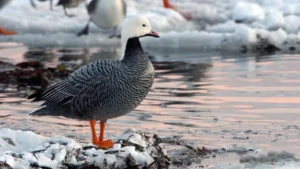
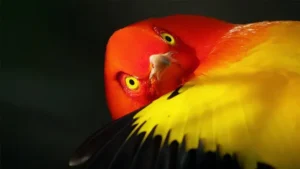
Leave your comment